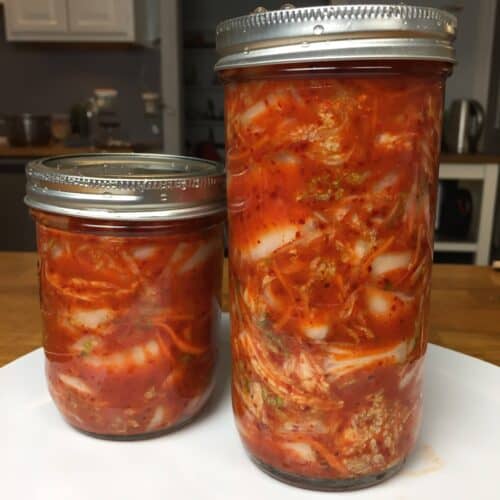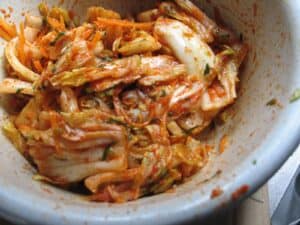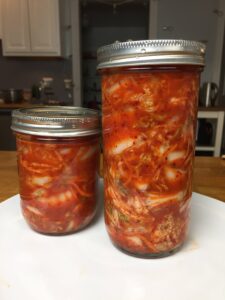
Small Batch Kimchi
Prepared Korean spicy side dish made from Napa cabbage fermented with green onions, garlic, ginger, and fish sauce among other things
Equipment
- 2 Canning jars
Ingredients
Vegetables
- 1 head Napa cabbage cut into pieces, soaked in salt overnight, drained
- 1 carrot medium, peeled and julienned
- 1/2 cup salt Kosher
Rice Paste
- ½ cup water 118mL
- 1 ½ tablespoons glutinous rice flour or mochiko 14g
- 1 tablespoon sugar 13g
Love Sauce
- 2 stalks of green onion thinly sliced, green part only
- 5 cloves garlic peeled, grated or pressed
- 1 yellow onion small, grated
- ½ pear ripe, peeled and grated
- 3 tbsp fish sauce
- 1 tbsp ginger fresh, grated
- ½ tsp kosher salt
- 1/2 cup red pepper flakes Korean style
Instructions
Preparing the Vegetables
- Rinse one Napa cabbage, cut it in half, and remove the core.
- Halve each half to quarter the cabbage, then cut your quarters into two-inch pieces.
- Add the cabbage to a large basin, bowl, or pot with the carrot.
- Sprinkle with kosher salt and follow with enough water to cover the vegetables.
- Soak for an hour and a half to two hours to give the saltwater time to penetrate the vegetables.
Preparing the Paste
- Meanwhile, pour water for the paste into a saucepan, followed by the glutinous rice flour. Whisk together to break up any lumps before turning on the heat.
- Turn the heat to medium and cook while stirring until thickened. Keep it moving to prevent the paste from burning.
- Add the sugar towards the end when the paste starts to thicken. The entire process should take about 5 minutes.
Preparing the Love Sauce
- First, combine the green onion, garlic, yellow onion, pear, gochugaru, fish sauce, ginger, and salt with the rice paste once it has cooled.
- Mix until well incorporated.
Adding the Vegetables to the Paste
- Once the vegetables have soaked for the required amount of time, drain them, returning them to the basin you soaked them in.

- Using food-safe gloves, massage the paste into the cabbage and carrots. Even go so far as squeezing the mixture to incorporate all that paste.
Canning the Kimchi
- Tightly pack the kimchi into nonreactive containers. (For this recipe I used one quart and one pint sized canning jar.)

- Put the lids and the canning rings on top and turn them slightly. Do not tighten as the kimchi will bubble and create gas as it ferments, so it needs a way to escape
- Leave to sit at room temperature for 24 to 48 hours — by then, the kimchi will be nice and tangy.
Notes
Note #1: When you put out your filled jars at room temperature, have a plate or tray underneath the fermenting vessel to catch any brine that may overflow.
Note #2: One trick for keeping kimchi for a long time is ensuring all the vegetables are submerged in brine. To do this, smush the kimchi into the brine after you take some out to eat so it is completely submerged, as it is this brine that preserves the kimchi. Doing this will also help get rid of air bubbles.
Nutrition
Serving: 100gCalories: 30kcalCarbohydrates: 6gProtein: 1gFat: 1gSaturated Fat: 0.1gPolyunsaturated Fat: 0.4gMonounsaturated Fat: 0.2gSodium: 2563mgPotassium: 210mgFiber: 2gSugar: 2gVitamin A: 1936IUVitamin C: 11mgCalcium: 50mgIron: 1mg
Tried this recipe?Let us know how it was!